Learn how to make authentic char siu bao (Chinese steamed BBQ pork buns) just like a dim sum restaurant. The buns have very soft, fine, and fluffy bread with a juicy tender pork filling. My recipe includes detailed step-by-step photos and a video to help you achieve the best result in your own kitchen.
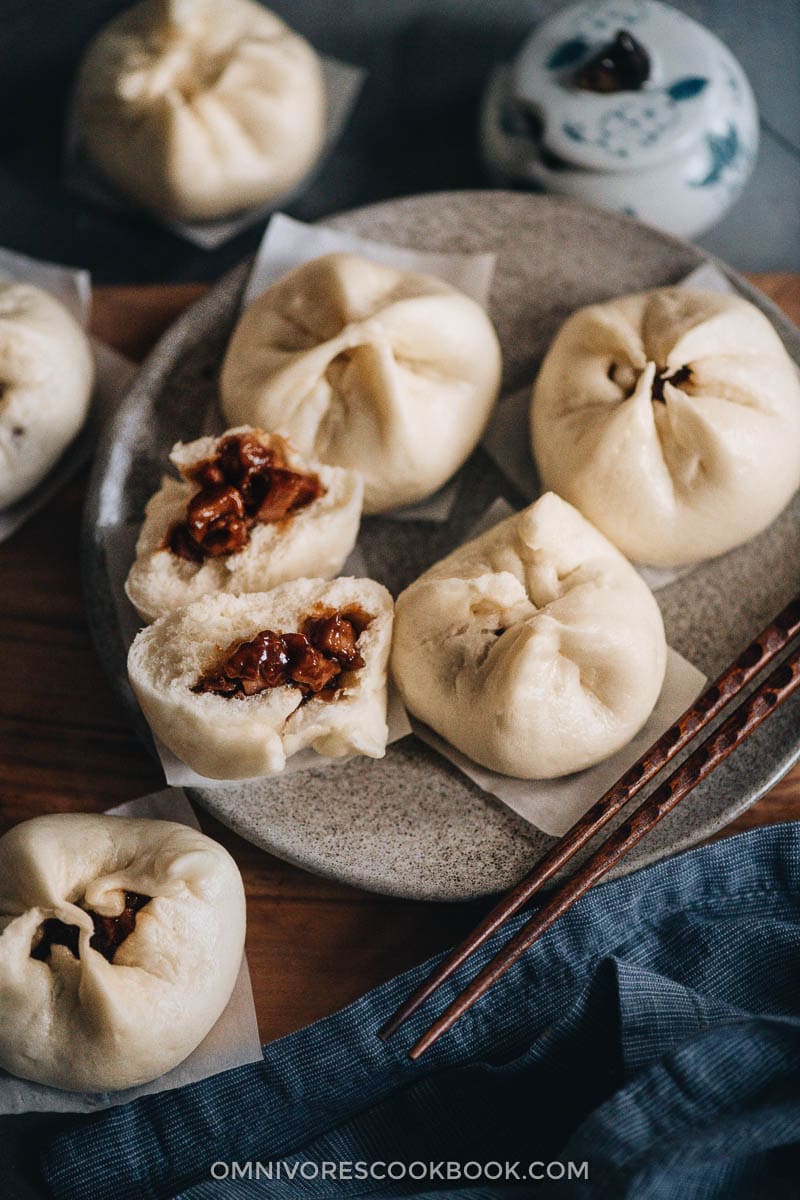
Char Siu Bao are the dim sum superstar that everybody loves. You cannot go to a dim sum restaurant and leave without having tried the super fluffy buns with chunks of BBQ pork in a bold sweet-savory sauce.
The beauty of these steamed BBQ pork buns is the soft and fluffy bread that is silky smooth on the surface. The buns crack open on the top, revealing the goodness inside and releasing its wonderful fragrance. The tender, chunky pork is coated with a sweet glaze, which pairs perfectly with the fragrant bread. It is a great way to use up leftover Char Siu (Chinese barbecue) roast pork and create something even fancier than the original dish.
Usually, something this decadent requires a lot of time and elbow grease. This recipe uses a KitchenAid stand mixer to knead the dough, so it’s quite approachable for any home cook. I also love the homemade version more than the ones from the Chinese bakery, which is often made with very fatty pork. I used lean pork to make these buns, which cuts the greasiness and still hits all the right spots.
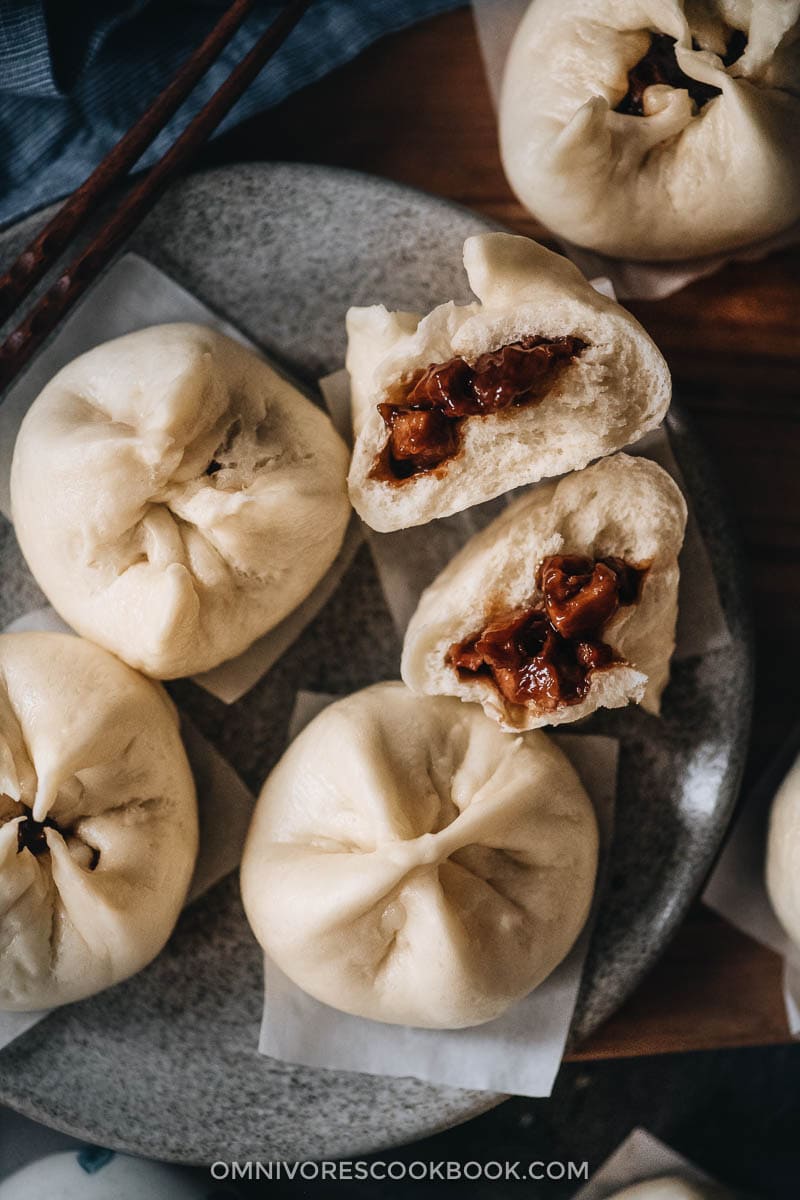
Why this recipe
- The dough is smooth on the surface, very fine in texture, and fluffy, just like the ones served at dim sum houses.
- The pork filling is super saucy, just like the authentic version.
- The recipe uses a KitchenAid stand mixer to give you maximum hands-off time. You can get these pork buns ready in under an hour once the dough is rested.
- These buns are freezer-friendly. You can make them in advance and impress guests at your dim sum party.
- I provided step-by-step pictures and a video, so you can easily follow the recipe without any prior dim sum making experience.
What flour to use
We tried both cake flour and Chinese low-gluten flour, and found that the low-gluten flour yields a marginally better result.
What is low-gluten flour
Low-gluten flour, or 低筋面粉 (Di Jin Mian Fen), is a type of flour blend that is commonly used in Asian dim sum, baked goods, and desserts. It consists of regular wheat flour with added wheat starch to create a low gluten percentage, which produces a soft-textured dough.
Note, low-gluten flour is different from cake flour, which achieves a low gluten ratio by using a different process to grind the flour.
I checked the protein content on both types of flour and found that low-gluten flour actually contains slightly more gluten content than cake flour, but still lower than all-purpose flour.
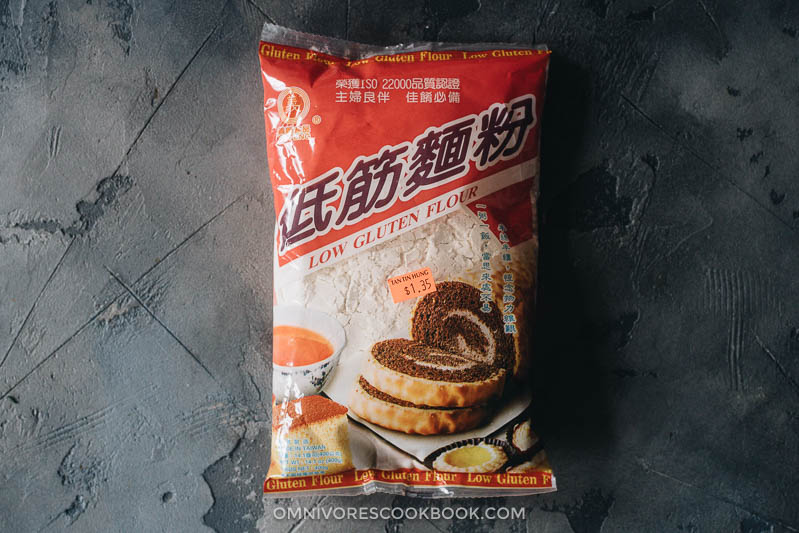
Cake flour vs. low-gluten flour
When using the low-gluten flour, the result of the buns is smoother on the surface and has that dim sum look. The texture of the dough is also a bit smoother. The cake flour yields a whiter bun (probably because the flour is bleached), but the surface is slightly uneven.
In conclusion, you should go with low-gluten flour if you’re looking for a perfect result that resembles the authentic char siu bao. If you cannot find low-gluten flour or want to skip a run to Asian grocery store, cake flour will do just fine.
Workflow
1. Prepare the dough – 1st rise
- Activate the yeast with warm water
- Mix the dry ingredients and wet ingredients in a stand mixer bowl
- Mix with a spatula a few times
- Let the mixer do the work
- The dough should be smooth once done
- Rest the dough until the size triples

If you do not want to use a mixer, it’s possible to knead the dough with your hands, especially if you have some bread making experience. You might need to knead the dough a bit longer to achieve a good result.
2. Make the filling
- Bring the sauce mixture to a boil to melt the sugar.
- Let the sauce cool, then add the cornstarch slurry. NOTE: it’s very important to let the sauce cool down first. Otherwise, the hot sugar will cook the cornstarch and form lumps.
- Bring the sauce to a simmer once again to thicken.
- Mix the sauce with the char siu pork.
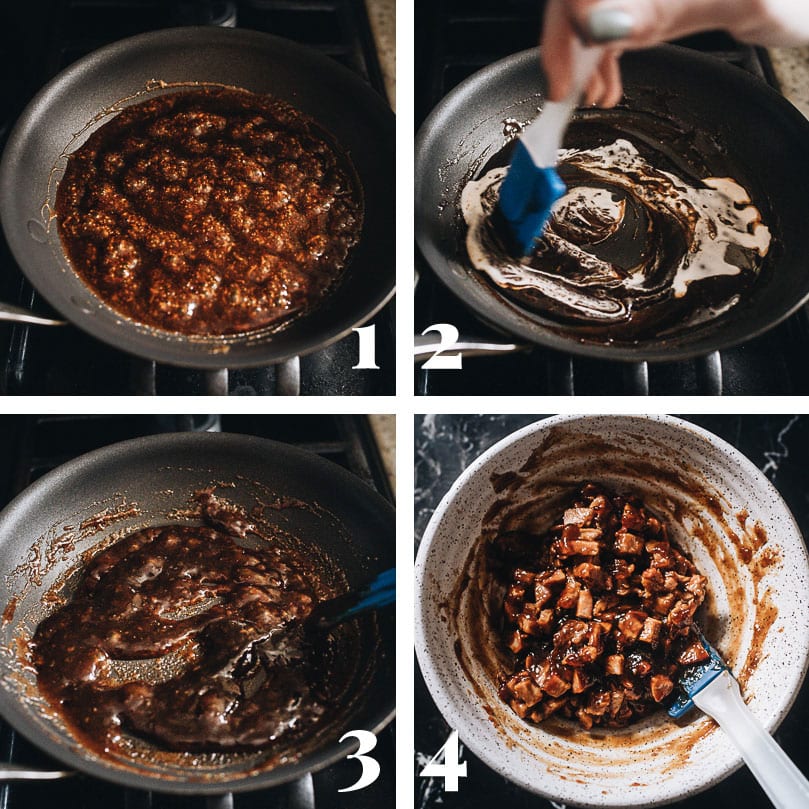
You can use the leftover pork from my Char Siu (Chinese BBQ pork) recipe, or you can purchase some char siu pork from a Cantonese restaurant. If neither works for you, try using some not-so-heavily-seasoned roasted pork from a grocery store deli. This recipe makes a very flavorful BBQ sauce so you can still get very good pork buns with regular roast pork.
3. Roll the dough
Once the dough is rested, it’s ready to use. You will need to punch the air out and divide the dough into 16 pieces.
To make the pork bun wrapper, roll the dough ball with a rolling pin to form a round disk that is thick in the center and thin on the edges. Because we will fold the buns later and that process will make top of the buns thicker. By keeping the center of the dough thicker, you will get an even thickness in the finished product.
Note: I highly recommend working on the dough in small batches. Once you divide the dough, keep the rest of the dough balls under a sheet of plastic wrap or a few layers of damp paper towels to cover the dough and prevent drying out.
Once you wrap the buns, use the same method to keep the buns from drying out while they rise the 2nd time.
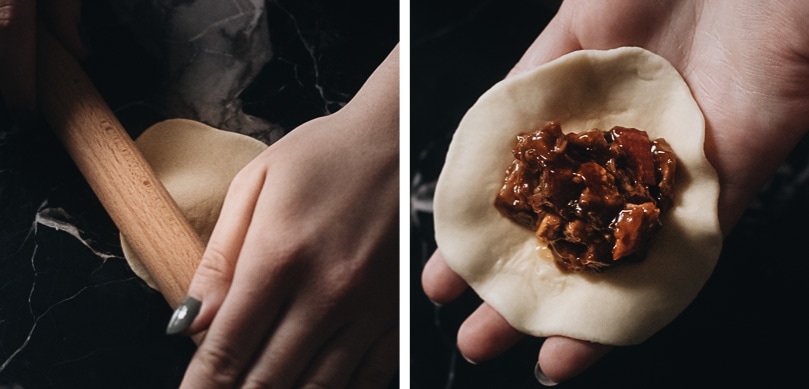
4. How to wrap char siu bao
If you’ve had char siu bao at a dim sum place, you’ll notice the buns are cracked and you can peek into them to see the juicy pork. To achieve the cracked result, you need a two-step process:
1st Fold
- Pinch together two sides of the dough
- Fold in the third side
- Press the edges together
- Fold in the fourth side
- Pinch the rest of the edges to seal the bun
- Now the bun is square and has a cross on top
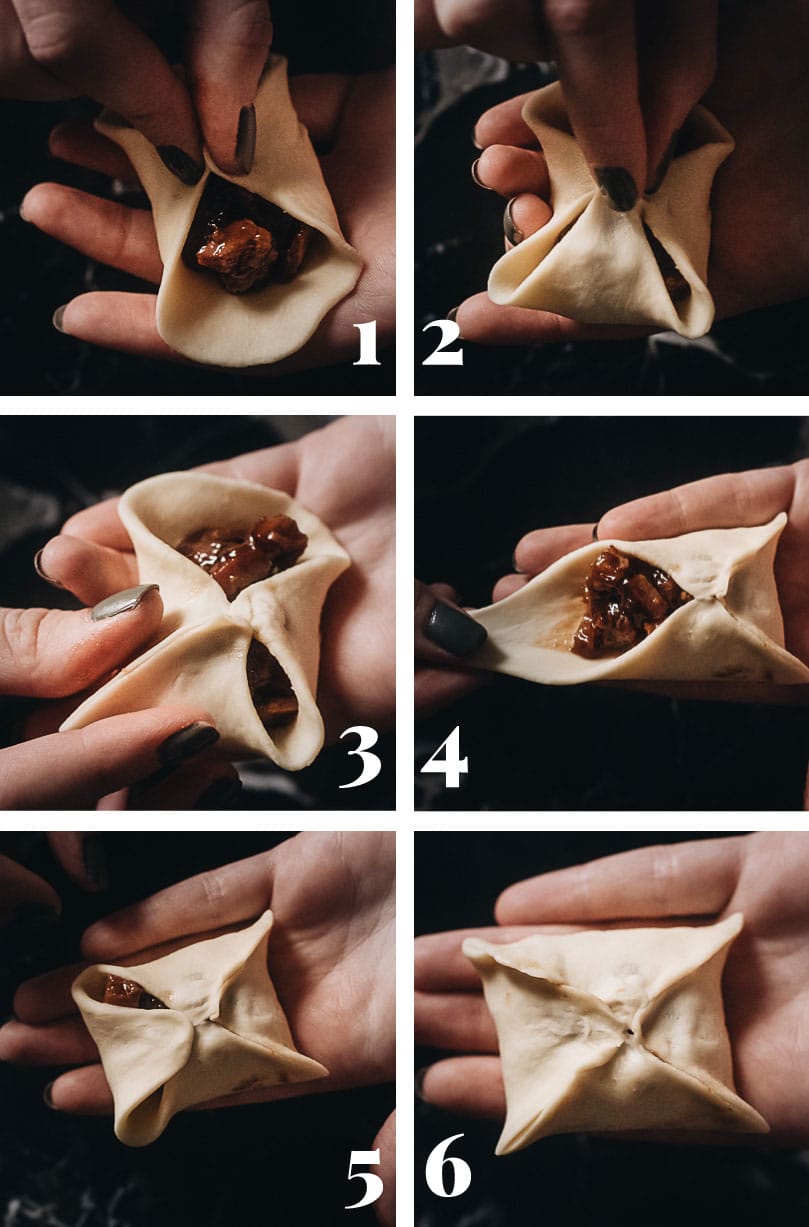
2nd Fold
- Gather the two pointed ends of the bun
- Fold and press them so the bun holds together but not super tightly (for the cracked effect)
- Work on the remaining two points in the same way
- Now it forms a round bun, which will crack open and smile at you once steamed
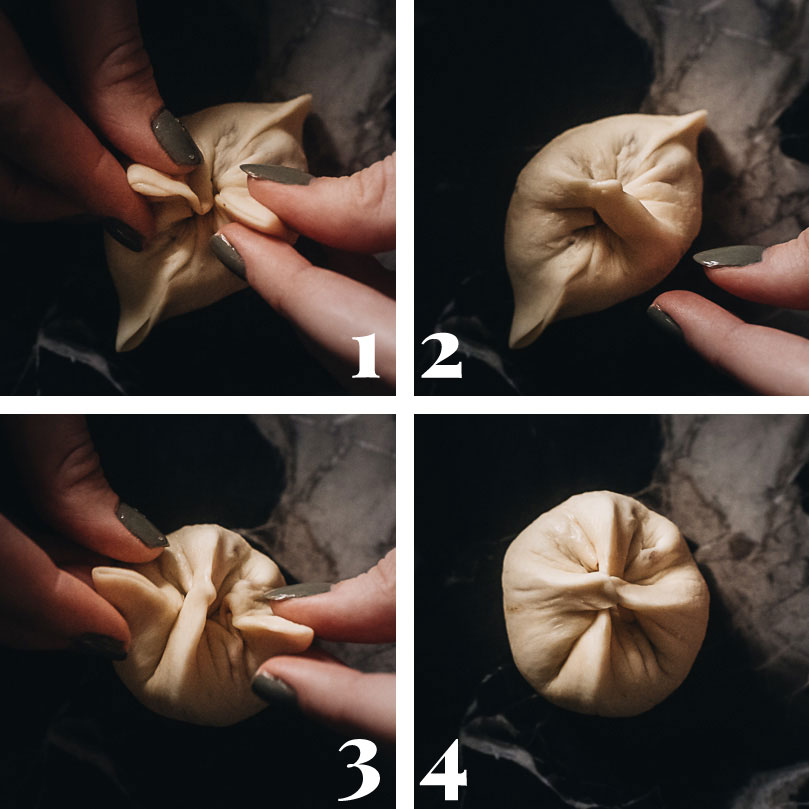
5. 2nd rise and steam
Once done wrapping, you need to allow the buns to rise for another 20 to 30 minutes before steaming.
Since it’s very hard to find a huge steamer to cook all of the buns at the same time, the best practice is to wrap and cook the buns in batches. Once you wrap 3 to 4 buns, start a stopwatch and start the steamer. The first batch of the buns is ready to cook once the stopwatch hits the 20-minute mark. Then you can work on the rest of the buns and cook them the same way.
Serve & storage
These BBQ pork buns are best when just steamed and still hot. They stay hot pretty well once cooked, in case you are preparing multiple dishes. Char siu bao are usually served as an appetizer or part of a multi-course meal. I also like to heat up leftover buns for lunch and dinner.
You can store leftover buns in the fridge for 3 days or in the freezer for a month. They hold up very well and taste great once reheated. Although I doubt you will need to store them for that long because they’ll disappear within the blink of an eye!
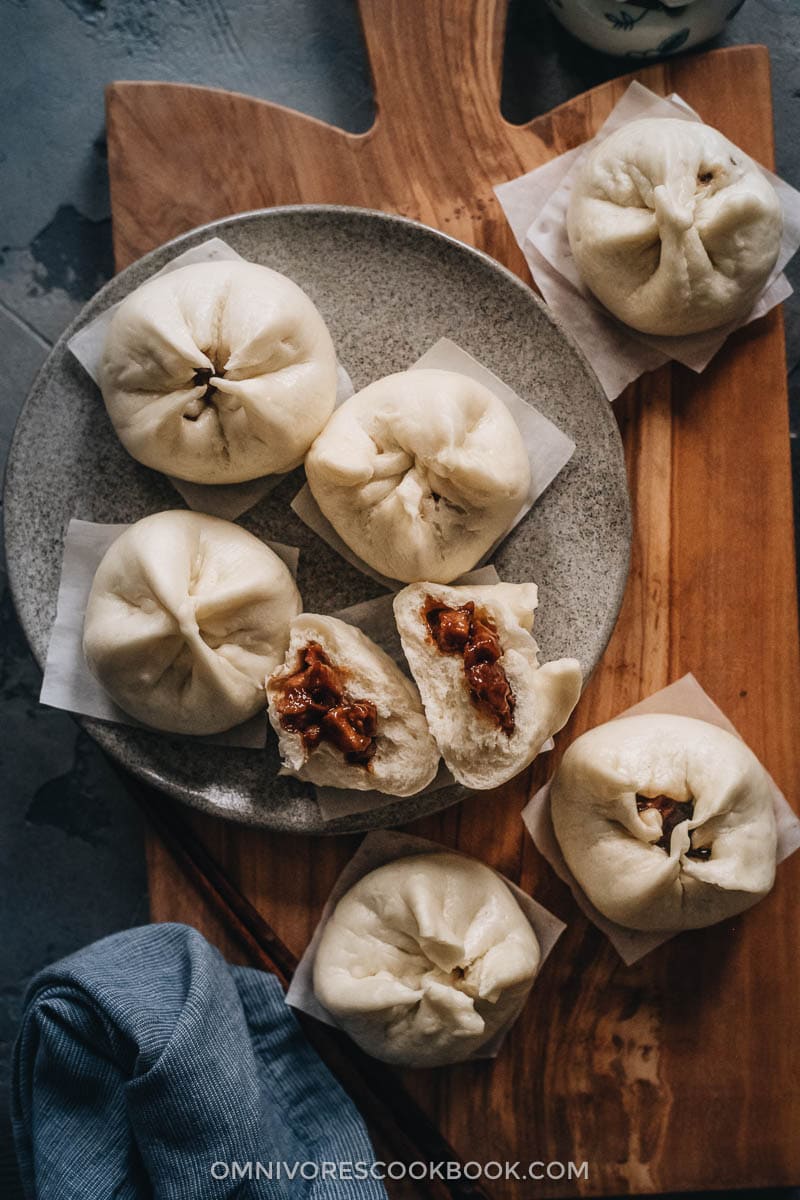
More delicious dim sum recipes
- Char Siu (Chinese BBQ Pork)
- How to Make Chinese Egg Rolls
- Wonton Soup
- Authentic Chinese Scallion Pancakes
- Steamed Ribs in Black Bean Sauce
- Chinese Steamed Custard Buns (nai wong bao)
If you give this recipe a try, let us know! Leave a comment, rate it (once you’ve tried it), and take a picture and tag it @omnivorescookbook on Instagram! I’d love to see what you come up with.
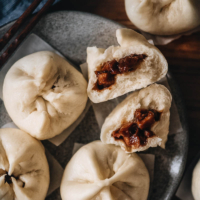
Char Siu Bao (Steamed BBQ Pork Buns)
Ingredients
Dough
- 125 g (1/2 cup) water , warm
- 7 g (1 packet / 2 teaspoons) active dry yeast
- 60 g (4 tablespoons) sugar
- 250 g (1 2/3 cup) low-gluten flour (or cake flour)
- 7 g (2 teaspoons) baking powder
- 7 g (1 1/2 teaspoons) shortening
Filling
- 1/4 cup low-sodium chicken stock
- 2 tablespoons hoisin sauce
- 2 tablespoons oyster sauce
- 2 tablespoons Shaoxing wine (or dry sherry)
- 1 tablespoon sugar
- 1 clove garlic , grated
- 1/8 teaspoon five spice powder
- 1 1/2 tablespoon cornstarch
- 1 1/2 cups Char Siu (Chinese BBQ pork) , chopped (*Footnote 1)
Instructions
Prepare the dough
- Add the water into a small bowl and warm to approximately 100-110°F (38°C), about 30 seconds in the microwave. The water should be warm, just a bit above body temperature. Add the sugar and active dry yeast, stir to mix well. Let sit for 5 minutes so the yeast will activate.
- While the yeast activates, add the cake flour and baking powder into your mixer bowl.
- Once the yeast is activated, you should see bubbles on the surface of the mixture. Pour it into the mixer bowl. Mix it with a spatula a few times, until the liquid is just absorbed by the dry ingredients.
- Install the dough hook on your mixer. Start at low speed, then gradually increase to speed setting to 6 out of 10. Knead for 10 minutes, until the dough is very smooth. Stop the mixer halfway through and scrape the dough from the sides of the bowl.
- Add the shortening. Knead on level 6 for another 5 minutes. The dough should be soft, smooth, and easily lifted from the bowl without sticking to your hands.
- Lightly grease a large bowl with butter or oil spray. Transfer the dough into the bowl. Cover the bowl with plastic wrap and let it rest in a warm part of your room, until the size triples, about 2 hours.
Prepare the char siu filling
- Combine the stock, hoisin sauce, oyster sauce, Shaoxing wine, sugar, garlic, and five spice powder in a small saucepan. Cook over medium heat until boiling. Turn to medium-low heat and let simmer for 1 minute. Stir occasionally until everything is mixed. Once done, remove the pan from the stove and let the sauce cool for 3 to 5 minutes.
- While cooling the sauce, add the cornstarch and 1 tablespoon of water into a small bowl. Stir to mix until the cornstarch is fully dissolved. Pour the cornstarch into the sauce. Stir to mix well. Turn the heat back on, to medium-low. Bring the sauce to a gentle simmer and stir constantly, until thickened. You should be able to draw lines on the bottom of the pan easily.
- Transfer the sauce into a medium-sized bowl. Add the char siu meat. Stir to mix well.
Assemble and cook
- Cut some parchment paper into 3” (7 cm) squares to hold the buns. You’ll need 16 squares.
- Punch the air out of the dough. Transfer it onto a lightly oiled working surface. Knead a few times to make the dough into a round ball. Divide the dough into 16 even pieces by cutting it into 2 even strips, then further cutting each strip into 8 small pieces. Each piece of dough should weigh 27 grams. Use your hands to roll and shape the dough pieces into dough balls.
- Wrap the buns one at a time. Flatten a dough ball using your palm. Use a rolling pin to roll the dough ball into a round disc that is thick in the middle and thin on the edges, about 2.5 to 3” (6 to 7 cm) in diameter. Carefully remove it from the surface and place it onto your palm.
- Place about a heaping tablespoon of the char siu mixture onto the center of the wrapper. Wrap the bun by pinching two ends of the dough together, then pinching the other two ends together. Press the dough edges together so it forms a square bun with a cross on top. Pinch the two opposite edges together, then repeat with the remaining two edges. Now the bun will be round. Check my blog post above to see the step-by-step wrapping pictures.
- Once done, place the char siu bun onto one of the cut parchment squares, pleated-side-down, then place it on a plate. Loosely cover it with plastic wrap to prevent drying out. Repeat the process to wrap the rest of the buns.
- Set a stopwatch (or timer) after wrapping the first bun, to keep track of the resting time. You need to rest the buns for 20 to 30 minutes before steaming them.
Steaming
- Depending on the size of your steamer, you might need to steam the buns in batches. What I usually do is prepare the steamer after wrapping half of the buns, so some of them are ready to be cooked as I work on the rest.
- To prepare the steamer, add about 3” (7 cm) of water to the pot and heat it over medium-high heat until the water starts to boil. Place the rested buns onto the steamer rack, leaving at least 2” (5 cm) between them, because the buns will expand a lot as they cook.
- Cover and steam for 10 minutes. Once done, remove the steamer rack and place it onto a trivet. Uncover the steamer rack carefully. Let the steam out and then transfer the buns onto a serving plate. Let the buns cool for 5 minutes before eating.
- Cook the rest of the buns using the same method.
Serve and store
- The char siu buns taste best when they are hot or warm. If you made them in advance, you can warm them up in the microwave or in a steamer.
- Once the buns have cooled completely, place them in a sealed container in the fridge for up to 3 days.
- You can store the cooked buns in the freezer for up to a month. To cook the frozen buns, thaw them completely in the fridge. Then heat them up in the microwave or in a steamer until heated through.
Notes
- You can use the leftover pork from my Char Siu (Chinese BBQ pork) recipe, or you can purchase char siu pork from a Cantonese restaurant. If neither works for you, try using some not-so-heavily-seasoned roasted pork from your grocery store deli. This recipe makes a very flavorful BBQ sauce so you can still make very good pork buns with regular roast pork.
Video
Nutrition
The recipe is updated by May 28, 2020 with a slightly adjusted filling formula. The original recipe creates extra filling you can use, and I’ve got some feedback saying the buns are too salty. We’ve retested the recipe and updated the filling with a more balanced sauce, and it will be just enough for 16 buns.
Lilja Walter is a part of the Omnivore’s Cookbook team and worked closely with Maggie to develop and test this recipe.

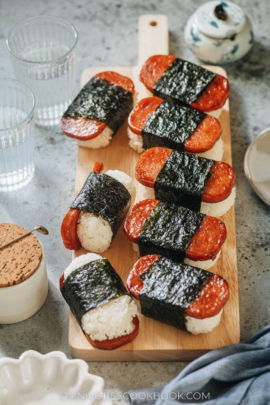
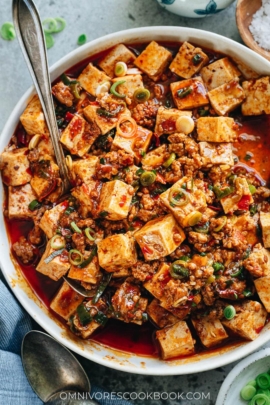

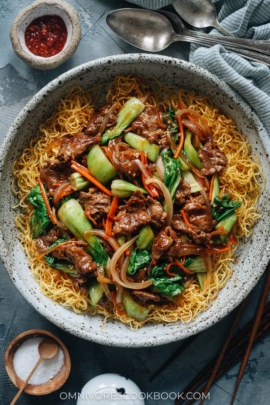
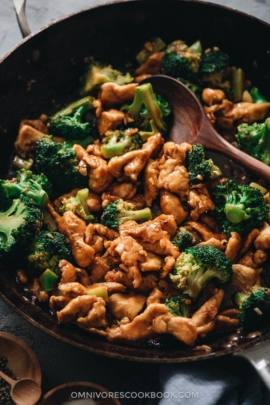
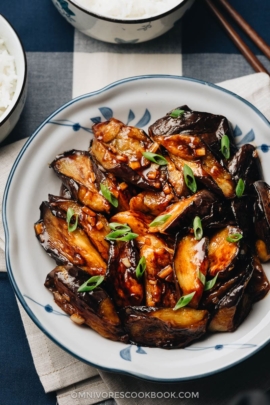






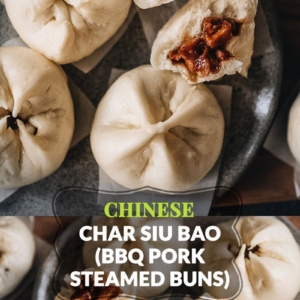
You rock! Now we know why something like a pig was created: He knew you’d make this! 🙂 Happy New Year. niio
Thank you! Happy New Year 🙂
I am anxious to make these (because I’ve loved every recipe of yours that I’ve tried), but I have a question. Is there any reason I can’t use the dough setting on my bread machine to do the kneading?
Hi Marsha, I think the bread machine would work just fine. My mom uses a bread machine and she made some of my baking recipes without any problem 🙂
Happy cooking and let me now how it goes!
Hi Maggie,
Thank you for sharing your yummy recipes with us. For the dough mixture, can oil be used instead of shortening?
These buns look delicious! Love the detailed photos 🙂
Can you make it without the oyster sauce?
Hi Maggi, will 2 cups of all purpose flour n 1 cup of cornstarch good enough? Also, can I substitute shortening with oil? Being in the lockdown now it’s hard to get some ingredients. Look forward to your reply. Thank you.
I think you don’t need that much cornstarch to make cake flour. The method I saw is to measure 1 cup all-purpose flour, remove 2 tablespoons from it, then add 2 tablespoons cornstarch so you get 1 cup cake flour substitution.
The shortening is actually quite important. I’m sure you can replace it with oil, but the texture of the buns will change.
I was so excited to try this after my success with your milk bread buns but I’m currently stuck – my dough barely rose after 3 hrs. Nothing wrong with my yeast either – it was a fresh 1lb package and I got a good foam when activating. I did have trouble kneading the dough at 6 on my mixer – it kept knocking my bowl out of the locked position so I had to do it at a lower speed and hold in place. After it didn’t really rise last night I stuck it in the fridge and now I’m wondering if it will be salvageable today if I let it get back up to room temp… curious if you have any tips! Thanks!
Hi Phyllis, I’m so sorry to hear your dough didn’t rise. The only problem I think that might have caused the problem is the sugar. I always weigh my ingredients and I used an online converter for measuring the sugar in spoons. Today I re-measured everything and realized that the sugar is closer to 4 tablespoons in real life, not the 5 tablespoons that are suggested online. Maybe the extra tablespoon sugar is too much for the yeast to handle.
Unfortunately I don’t think there’s anything you can do with the dough. Because the yeast either died somewhere along the rising process, or if there is still any yeast alive the dough doesn’t have any sugar left to eat.
Fascinating. I’ll give it another shot with less sugar and hope for the best :).
I really hope it will go well this time! Fingers crossed. Let me know how the buns come out 🙂
Happy to report that round 2 was successful! Cut back the sugar and had no issues with the rise. Only thing I did wrong was I forgot to flip them for the 2nd rise so the bottoms are a little flat but now I know how to fix for next time! Super tasty, thank you again! Can’t wait to try more recipes!
Amazing! I’m so happy to hear the second time worked and you liked the result 🙂 Can’t wait to see what you’ll be cooking the next!
Hi Maggie, I’ve been using many of your recipes, and my family loves the Char Siu. The dough for these buns are perfect, a little sweeter than some other recipes, which is what I was looking for. The filling, however, is cloyingly sweet. My daughter, who wanted a sweeter bbq pork bun than I’ve made the past, also thought these were over-the-top sweet, and a bit heavy-handed on the 5-spice powder. The sauce is almost the same as your marinade/glaze for the Char Siu, a recipe that we love. I guess it was just too much of a sweet and flavorful sauce for the bun filling. I’ll definitely be using the dough recipe again, but will cut back on the sugar and 5-spice. It was a great way to use leftover Char Siu. Thank you for your detailed, authentic recipes!
Maggie, do you have any recommendations for what to do with extra pork filling left over from this recipe? I ended up with quite a lot still left over! It’s delicious, but I’m curious what the best applications are.
Hi David, you can use the leftover filling to make fried noodles or fried rice.
For noodles, you can refer to this recipe: https://omnivorescookbook.com/pork-lo-mein since the filling is coated with sauce already, I think you should halve the sauce in this recipe.
For fried rice, use this recipe: https://omnivorescookbook.com/chicken-fried-rice/ Skip the chicken and marinade. Same idea like the noodles, you should halve the sauce, or a splash of soy sauce might be enough.
Thank you, these looks amazing! I see that you say to freeze the buns after steaming, I was considering freezing the buns before steaming, then allowing them to come to room temp before steaming at a later time. Do you think that would taste fresher or should I just steam them all when I prepare them?
Hi Jacqueline, I’m afraid the freezing will mess up the second rise (once you wrap the buns, they will need time to rise before steaming) and the buns might collapse after thawing and handling. I would recommend freezing the steamed ones and they should taste just as fresh.
PS. Even commercial brands always sell frozen cooked buns. I suspect it’s due to the same reason.
I never rate recipes, but I feel this one deserves an exception. I followed the recipe to the letter (ok I winged it a bit when I closed up the baos), and even though mine didn’t come out as cute, these are amazing! I also used the Char Siu Pork recipe and had enough pork to double this recipe, and I still have a bit pork left over for fried rice. The dough is very workable, soft, and forgiving of my mistakes. I’m so excited that you shared this, and it definitely isn’t as scary as I thought it’d be. This should have more stars than I can give. I can’t speak enough for how great it is!
Well I may not have executed this recipe exactly but pretty darn close. I used unbleached all purpose flour instead of the low gluten flour. My dough did not rise much at all. Could be a number of factors but that would not be my biggest problem with this recipe. It’s simply too salty, reduce or leave out the oyster sauce. It’s so salty, that I can’t eat it without drinking water or something bland. Another surprise was my bao came out golden brown instead of white. Could be the unbleached flour instead of bleached flour. Still it went into the steamer white and came out brown as if it was baked. I’ll make it again but will reduce the salty oyster sauce. Hopefully the bread will rise better.
Hi Peter, I’m sorry to hear you didn’t like the result of the recipe. The dough is designed for cake flour (or low-gluten flour) so I’m afraid all-purpose flour is not gonna work. I’m not sure why the dough came out golden brown. I might have something to do with flour, but I don’t think unbleached will cause a problem. We actually test it many times and the cake flour result will be slightly whiter than low-gluten flour, but none is golden brown.
We’re making this now. Pork has been marinating since yesterday. Hoping for the best as I had to use almost a cup more cake flour than called for in order to form a dough ball. I’ll post an update!
Do you have any idea if I could use a Zojirushi automatic bread maker to prepare the dough? We don’t have a kitchen aid. Also, would butter or some type of oil work rather than shortening. Thanks so much! We love your recipes!
Hi Tarah, I think you can use a bread maker. My mom uses a bread maker to make my baking recipes. They usually come out alright but it might require a longer kneading time.
Both butter and oil should work fine.
Butter – you should use softened butter and add it at the same stage. It will affect the texture and taste of the dough. The dough might come out a bit wet due to the water in the butter.
Oil – you should add at the beginning. If the dough is too wet after a bit kneading, you might need to add more flour and knead it further.
I think butter will work better because it requires less moderation of the recipe.
Hello,
I can’t seem to find the gluten free version of the bun dough recipe. Would you please let me know where I might find the gluten free version ?
Thank You !
Hi Maggie, so grateful for all the detailed recipes! I’ve successfully made dumplings in my life primarily because of your site and my belly and my boyfriend thank you. Question about this recipe. I will probably have to make my own cake flour at home but am confused about the amount of cornstarch to use. Is it 250gm Total in flour I need? I always measure by weight and thought 120gm is one cup but the recipe says 250gm is 1.66cups. Please let me know if there’s something I’m missing. Thanks again for everything.
Hi Rosalie, the 250g is the total cake flour you need. If you can measure by the weight, please ignore the cup measurement. It’s not very accurate and the number varies a lot depending on how you measure it. The 1 cup (120 g) is probably the sifted flour. If you use slightly packed flour, the weight will increase a lot. Anyhow, you should use the weight in this recipe. Happy cooking and hope your buns turn out great!
Oh that makes sense… Great, let’s do this thing! Thanks so much Maggie!
I see chicken stock listed as an ingredient for the filling, but it is not mentioned anywhere in the instructions. Do I put it in the filling or omit it? Thank you!
Hi Katie, you will add the stock while making the sauce with other sauce ingredients.
I just updated the recipe so now it reflected it in the instructions. Thanks for letting me know!
Hi Maggie! Thanks for this recipe my buns turned out so soft and yummy! However, I have a question. I can’t seem to get my Kitchenaid to successfully knead the dough. My dough was not able to wrap around the dough hook and it seemed drier than the one in your video. Not sure if I did something wrong? I followed the measurements in the recipe and used a scale as well.
hi Maggie, first of all, congratulations on your exhaustive, inspiring site
i have looked all over the net and cannot find any answer at all. we all know what a char shui bao, and most of are familiar with dai bao, but then there is third bun, which remains a mystery online; i know how to say it cantonese (more or less), but this might not anglicize well. it sounds like sang gnui bao (raw meat bun, though thouroughly cooked) than sam gnui bao (three meat bun). it’s even bigger than the dai bao; a layered affair of chicken and pork, much like the a dim sum beef ball, but packed tighter, with julienned water chestnuts—and huge. i hope you can help me with this
thank you. and Merry Christmas!
Came out very dry and not enough sauce. Why is your filling so dark??
Hi Jean, I’m sorry to hear your buns didn’t turn out as you hoped. One reason I can think of is you reduced the sauce a bit too long and it congealed too much? My previous filling recipe used a bit more sauces (when I shot the photos) but I’ve received some comments on the filling being too salty. So I’ve retested and updated the recipe later using more stock and less sauce but didn’t update the photos.
I made these for dinner tonight – the Char Siu and the Bao (both your recipes) – and wow! They tasted exactly as I’d hoped – light, fluffy dough with a sweet and fragrant pork filling. Both recipes were really easy to follow, and I loved having the vid to fall back on (eg: does my dough look right?). Thank you so much for expanding my cooking horizons with such delicious recipes.
Greetings from NSW, Australia.
These steamed pork Buns were amazing. I used your Char Siu tecipe for the pork and it was so easy. My Hubby and son are begging for more, so much so I am using this as a bribe to get things done around our home. Thank you Maggie.
Perfection. I jave just started following your blog and it has been amazing. I wanted to add I am a professional chef and I am amazed how accurate your recipes are. The steamed buns are delicious just like from a great dim sum place. The only thing I changed was I used butter instead of shortening and it was very good.
Love it! I don’t keep cake flour on hand so I used all purpose flour and replaced 10% of it with cornstarch (so, 225g flour and 25g cornstarch) and it turned out great. I actually made a batch of your char siu specifically for turning into these buns so it was a 2-3 day process for the whole thing and I have l no regrets
I love the Char Siu pork so much, unfortunately there is never enough left overs to make these buns. These buns are a time consuming process when making the pork from scratch, but on my are they worth the effort. I have to make them as an appetizer and they don’t even make it to the table before the teens come and start grabbing them off the plate. Such a wonderful mixture of flavors and the bun has a slightly sweet flavor. This is our favorite and most requested recipe.
Can I also use chicken tight? I can’t eat pork.
Yes! Chicken thigh will work great in this recipe.
I don’t have a stand mixer. Could I use a food processor or muscle it out?
You can definitely hand knead the dough. It is a very soft dough so I wouldn’t use food processor.
Delicious! My shaping needs more work but this was the perfect recipe to use up some leftover char siu I made the other night